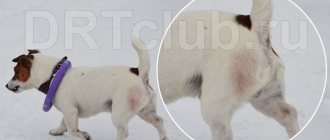If you've ever witnessed a fight between two dogs, you know how scary it can be. Dogs can cause serious harm to each other during a fight or attack. In some cases, the injuries can even be fatal.
When your dog is involved, it's hard to resist the natural instinct to intervene and stop the fight. However, trying to break up a fight the wrong way can land you in the hospital.
Luckily, there are alternatives to separating dogs. As a dog owner, you should know safe ways to stop fighting in case you ever find yourself in such a situation.
How to stop a dog fight
Dog fights are an extremely dangerous situation even for large dogs; and for small dogs such a conflict can be fatal.
Why do dogs fight?
Firstly, fights are most often started by aggressive, unsocialized and simply poorly trained dogs.
The aggressiveness of such animals can be congenital and intensified as a result of inept upbringing, or it can be acquired during life, for example, a dog has become unpredictable as a result of cruel treatment.
Secondly, males most often take part in fights. Dominant, non-castrated males perceive the very presence of another male (even the smallest) on their territory as a mortal insult to their masculinity.
Thirdly, dogs, as representatives of pack animals, when performing the ritual of meeting and getting to know each other, find out each other’s status. For balanced dogs, this ceremony takes place peacefully, and if fights do occur, then, as a rule, the owners are to blame. You cannot interfere with the ritual of introducing two adult, sexually mature dogs (for example, trying to put your pet on a leash). The approach of the owner will be regarded by the dog as support and a signal to fight.
Fourthly, regular fights can be caused by dogs living in the same house. Most often they share the territory and love of the owner.
How to properly separate fighting dogs?
1. It is not always wise to intervene in a conflict between pets of approximately equal strength and size. You could get seriously hurt.
2. Shouting at fighting dogs and hitting them with anything is pointless. Such actions will only inflame the fight.
3. It is prohibited to separate dogs by their collars. In the heat of struggle, the animal is driven only by the instinct of survival, the authority of the owner fades into the background. An outstretched hand is perceived as nothing other than a threat, to which the animal responds with its teeth.
4. If at the time of the fight both dog owners are nearby, then you need to try to pull the fighting dogs apart in different directions, grabbing them by their tails or hind legs. Opponents must not be released until they lose sight of each other, otherwise a second fight is inevitable.
5. If only one owner has the chance to witness a dog conflict, you can try to do the following: place a loop from the leash around the leg of one of the dogs, and carefully retreating, find a place where the leash can be tied (a tree fence). After this, try to pull the second dog by the hind legs, as described in the previous paragraph. Unfortunately, this technique is not applicable in a large open space. You cannot drag just one dog if the other has the opportunity to move freely.
6. If there are still no helpers nearby, but there is a house nearby, you can separate the dogs by pouring a bucket of water on them or throwing a jacket over the dogs’ heads.
How to prevent conflict?
1. Stay away from dogs that show signs of aggression.
2. When meeting a potential rival, do not violate the ritual of introducing animals. It’s better to immediately move some distance away from them and call the dog to you in a confident voice.
3. Don’t be nervous and don’t scream so that your pet doesn’t rush to protect you.
4. If your pet is prone to aggression, never take him for a walk without a muzzle and a leash.
5. Neutered individuals are less likely to become targets of attacks.
6. It is easier to control an obedient dog. Commands such as “Sit”, “Lie down”, “Next” must be obeyed by your four-legged charge without question.
7. The owner must give the same amount of love and affection to pets living in the same house, and also be the unconditional leader of the entire “pack”. Then the dogs will not sort things out among themselves.
Aggression between dogs, what to do if two dogs living in the same house fight
Aggression between dogs living in the same house is far from uncommon recently, as many owners began to have 2 or more dogs.
Causes of aggression between dogs
There are a lot of possible reasons; in this article I will focus on the most common ones and give recommendations for eliminating them.
— the first reason is the problem of dominance. The dog inherited this behavior pattern from his ancestor, the wolf. Wolves live in packs, and in the pack there is a strict hierarchy, where each representative knows his place in “society”, and at the head of the entire community is a leader, whose authority is indisputable. The higher a wolf stands in his pack on the hierarchical ladder, the more rights and privileges he has.
The leader always goes first, makes all the decisions and receives the main share of the prey, all the females are his property and he will cover as much as he can, and everyone else will be content with what is left. I think the reason for being a leader is obvious.
This behavior is also typical for dogs living in a pack. It should be understood that the owner and the dog or dogs are a pack, albeit not a large one, but there will be a leader in it. I emphasize that it should not be, but WILL BE. And whether you or one of the dogs will be this leader is up to you to decide.
The desire to lead is inherent in dogs by nature, so they will still compete with you or with each other.
— the second reason is very closely intertwined with the first, when such hierarchical connections become unstable. This means that one dog, perhaps a puppy, has matured and is beginning to claim leadership, or one of the dogs has grown old and can no longer be a leader and its leadership rights are being challenged by a younger and stronger one.
In this case, you cannot leave the dogs alone - they will figure it out on their own, or punish one and reward the other for aggression, as this can lead to aggravation of the problem
— the next reason is insufficient activity. If animals are constantly idle or walk little, or worse, are constantly in an enclosure, then aggression towards each other may occur due to excess accumulation of energy.
- poor training - You will not be able to control your dogs if you do not train them to carry out commands on demand, I think this is the basis of all behavior corrections.
How to correct unwanted behavior or how to stop fighting between dogs
First stage
- Firstly, you must be the leader of your pack. Your authority should be unshakable, then the dogs will respect and listen to you, this will help you in implementing the following recommendations.
- secondly, you need your dog to know and follow all your commands - obedience is the main criterion for dogs to recognize you as their leader. To do this, not only demand that commands be followed, but also always go out of any door first, and only after that allow the dogs to go out one at a time.
If you can’t cope on your own, hire a dog handler so that he can go through a general training course with you and your dog.
How to break up a dog fight - tips from a dog handler
RUBRICS
ADDRESS CATALOG
NEW ENTRIES
Veterinary clinics
Veterinarians
Pet stores
How to break up a dog fight - tips from a dog handler
Two dogs fighting can be a scary situation - and get injured. You will learn how to stop dogs that are fighting and not get injured in the process by reading the article.
Even dogs who are best buddies can get into fights sometimes. This usually occurs when there is confusion about the dog's place in the pack . A fight can break out when a dog lower in the hierarchy receives food before a dog higher in the hierarchy, resulting in the dog higher in the hierarchy defending the food it considers rightfully its own. Dog fighting can be prevented by understanding and strengthening the natural hierarchy within the pack. But what is the best way to stop a dog fight when it happens, and where to start?
To stop a dog fight, make sure no people get hurt.
This is the first rule. Trying to separate two fighting dogs - especially large dogs - can result in serious injury. Dogs that fight do not intend to harm their owner, but if a hand gets in their way, there is a high probability that the owner will be bitten. Don't even try to separate the dogs from the front. The safest way to separate two dogs is to place something between them, such as a metal trash can lid or a large wooden shield.
If this doesn't work, some dog owners may pull their dogs' tails harshly until they come apart. This only works if two people do it - each must pull each dog's tail until they separate. This can be difficult as the dog can easily spin and bite. Keep in mind that when dogs fight, they are in some kind of trance and they don't want to bite their owner - it's just a reflex response.
Two tools that can be used to stop a dog fight. Two dogs that are fighting can sometimes be separated by sound signals or water. If two fighting dogs are outdoors, grab a hose and spray them with a stream of cold water. This sometimes brings them out of their “trance” and aggressive situation. If you don't have a hose, using a bucket of water or a water-based fire extinguisher will work, too.
Keep the air horn in your hands so you can use it in the event of a fight. This horn produces a loud, high-pitched sound that startles dogs that fight long enough to release the tension. This is a great investment for those who have more than one dog.
Stopping a dog fight by keeping one of them away from what is already happening elsewhere. The best way to stop a dog fight is to keep one away. Be a strong alpha leader and respect hierarchy. Don't feed or praise a dog lower in the hierarchy before doing the same for the first one. Learn to recognize signs of tension between two dogs and separate them immediately.
Bottom line? Try to prevent dog fights before they start, but if a fight does break out, you should be prepared by having an air horn or a hose that can spray cold water.
What not to do
Having seen that your pet has entered into a fight with another animal, you absolutely must not panic, scream or climb between them to separate them. During a fight, the animal’s nervous system is in an excited state, and the pet cannot understand who exactly is pulling it away from the enemy, so without meaning to, it can plunge its fang into the hand of its owner.
The situation becomes dangerous when representatives of fighting breeds fight - they will try to win even when they themselves are wounded. Hitting and screaming at excited animals is not only useless, but also dangerous. This behavior will lead to even more anger.
Don't panic if dogs are fighting, the main thing is to maintain composure
There can be absolutely any reason for a dog fight, the main thing is that if the situation gets worse, try to take all measures to avoid a fight.
Source
From personal experience
I have a Doberman, and my daughter has a Great Dane, or rather Great Dane. She is older and larger than the Doberman, she dominates him and although our house is his territory, he is inferior to her because when he was brought from the shelter, the Great Dane was already in the house and he had to get used to her as a puppy and obey.
For some time during puberty, he even tried to take possession of her sexually, but he could not get hold of her and constantly received stars from the dog.
Now they are two adult dogs, they get along great when my daughter leaves the Great Dane with us for a few days. The only thing is that the Doberman doesn’t like it and is very jealous when I pet my dog.
He constantly barks and tries to drive her away from me.
What stories do you have about your dogs fighting? Please write in the comments.
The danger of conflicts for people and dogs
It must be remembered that dogs, although they are pets, still have a wild nature. These born predators, with their understanding of the world around them, can behave completely inappropriately, causing harm even to their owner during a fight with their relative. Conflicts between dogs pose a serious threat to the safety of both the animals themselves and the people around them. Being in an unbalanced, aggressive state, the dog can rush at nearby people or another owner.
Conflicts between two dogs can end sadly. The resulting serious injuries may threaten the life of the animal.
Unfortunately, quite a lot of dogs are admitted to veterinary clinics after being injured as a result of a fight. These lacerations have to be stitched up, and then a long course of rehabilitation follows. But it all depends on the extent of the damage. Dogs will never inflict only minor injuries on their opponent. The enemy's main target is the carotid artery. Therefore, the conflict may end in the death of one of the rivals.
The same goes for people. In addition to passers-by who witness a fight between two dogs, the owners themselves may also suffer.
Disease
What are you talking about, we were friends!
A typical picture: a calm, balanced dog suddenly begins to attack its own kind. The owner is shocked, this has never happened, the pet has always treated his own kind favorably. An analysis of the situation begins, the owner tenses up and remembers: the pet began to attack other dogs after he got sick.
Yes, a sick dog is quite capable of showing aggression. This is explained by an attempt to protect themselves, because illness is a reason to be attacked or killed by their own relatives. For example, stray dogs that gather in packs do not stand on ceremony with sick “household members”; they are destroyed.
Pets are more loyal in this matter, but the instincts of self-defense at the time of illness do not go away. No one wants to be strangled or eaten by their own kind.
Mental problems
Showdown
And this happens in our time. Even among purebred dogs purchased in mono-kennels from champion parents. Unfortunately, mental problems are especially common in long-haired “show class” German shepherds. At the sight of a fellow dog, the shepherd begins to “yell” at the top of his lungs, tries to rush at the other dog, his withers standing on end.
Attempts to distract and switch do not work. The dog continues the tantrum with an attempted attack until the potential enemy is behind or disappears from sight. Not only “German show dogs” are guilty of this behavior; other large, medium and small breeds do the same.











